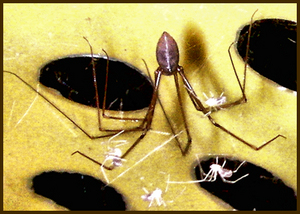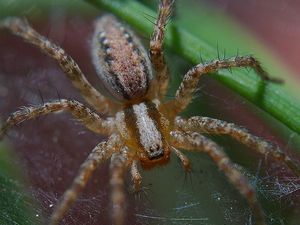The spider is an important part to the biological control of insects that would otherwise feed on your shrubs and plants. Most spiders are harmless. It is rare that you need to seek medical attention if a spider bites you.
A spider has four legs on each side of its abdomen. Its head has six to eight pairs of eyes. The thing I find amazing about this little insect are the intricate webs they spin. Sometimes they are perfect, but other times you can tell that they caught something in their web because it is torn or ragged. As the spider grows, they will continue adding on to their web, always making it bigger.
The purpose of a spider web is so the spider can catch its prey. The silk of the spider web is made of proteins and some are strong enough to catch insects much bigger than the spider. Most webs are wheel-shaped but sometimes they can be shaped like a funnel.
Spiny Orb Weaver
The male spiny orb weaver is only 1/16 to 1/8 inch. The females grow to 3/8 inch. They spin a web that is 10 to 12 inches across but sometimes their webs can be 30 inches in diameter. This spider is also known as the spiny-backed spider. It gets this name from the spines protruding out from their abdomen. They trap and eat many different insects like flies, moths, small beetles, wasps, bees, and mosquitoes. This spider has a colorful, hard abdomen like orange, white, or yellow with red markings. The spiny orb weaver is often found living in the southeastern United States.
Nephila clavipes
The Nephila clavipes spider goes by a number of names like the golden silk orb weaver, giant wood spider, banana spider, or writing spider. One of the easiest ways to recognize this spider is from the web it makes. Their webs are one of the strongest and they often add a zigzag pattern. They spin webs that are 3 to 6 feet in diameter. You can find this spider in Florida and the southeastern states. The Nephila clavipe spiders are orange and brown spider with feathery tufts on their legs. The female spider is large, ranging from 1 to 3 inches in length, while the males are only 1/2 inch in length. The diet of this spider is flies, wasps, or small. Should this spider bite you, it will feel like a bee sting.
Funnel Web Weaver
The funnel web weaver, also called grass spiders, usually spins an invisible silken web in grassy areas. The web is like a large sheet of nonstick webbing with a funnel extending off to one side. At the bottom of the funnel, the spider waits for a bee, fly, or other unsuspecting bug to land. The unsuspecting insect slips through the first web sheet to the next one below. When this happens, spider runs out of hiding. It grabs the bug and quickly wraps it in a silk casing. The spider carries the wrapped parcel into the funnel where it will be eaten later. The female spider grows to 0.3 or .45 inches and the male spider is .24 or .35 inches. Another way to tell the difference between the male and female spiders is by the length of their legs. The male spider has longer legs, measuring about 1 inch. He also has a more slender abdomen. The funnel spiders are brown or gray with banded legs. They also have spots on their backs. There are over 400 species of this spider across North America.
When you find a spider in your yard, don’t destroy them and their webs. They will help take care of your bug problems without harmful pesticides.


